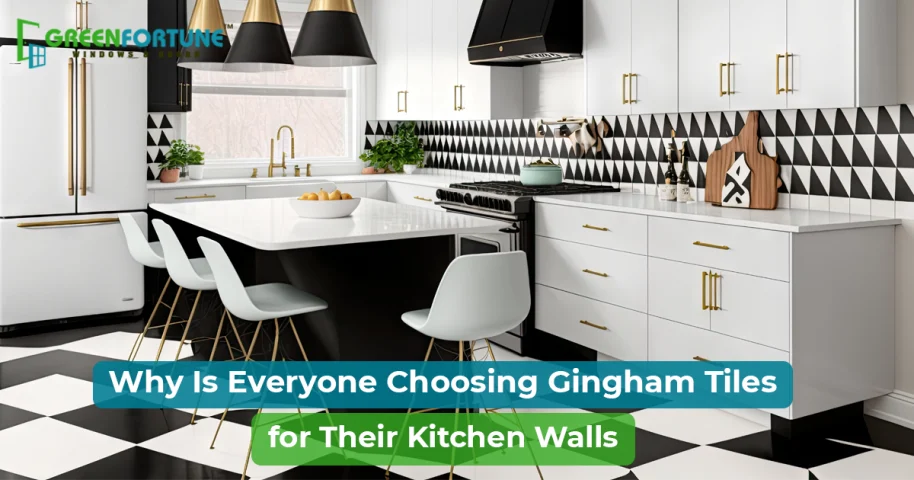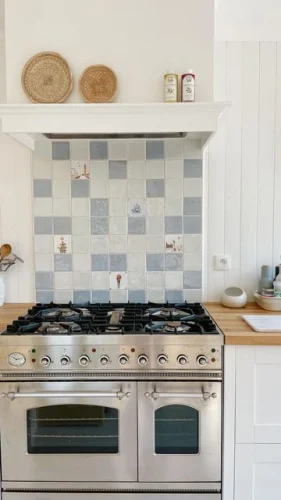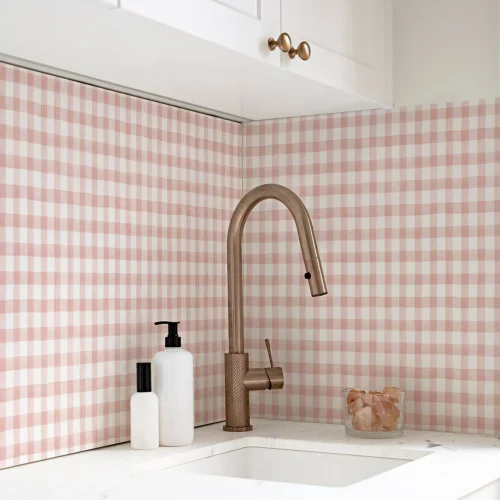
Benefits of uPVC Windows in Commercial Buildings
July 14, 2025
Upgrade Your Windows with These Eco-Friendly window Insulation Hacks
July 14, 2025Table of contents
A gingham-style backsplash can instantly change the look of your kitchen or bathroom. It has a clean, checkered pattern that feels both modern and classic – all at once.
It’s also one of the easiest ways to highlight the space behind your sink, stove, or taps. You don’t need to renovate the whole kitchen to make it stand out. And if you're building a new one, this pattern adds structure and style without much effort.
In this blog, you’ll find out how to pick the right gingham tile colors, styles, and what to keep in mind before you get started.
What is a Backsplash?
A backsplash is the section of wall directly behind your sink, stove, or countertop. These areas are more likely to get damaged by water, oil splashes, food stains, or heat. It’s usually made using materials like tile, glass, acrylic sheets, or stone to protect the wall from damage. It saves the wall paint from damage, makes cleaning easier and helps the kitchen look more finished and neat.
What is Gingham Tile Backsplash Design?
Gingham tile design is a checkered pattern made by placing two different tile colors in an alternating layout. A uniform grid is created by alternating two tile colors, usually one light and one dark. It is inspired from the gingham fabric design and when this pattern is used to design a backsplash, it’s called a gingham style backsplash.
Also read: Top Wall Tile Design for Homes to Elevate Your Interiors
Benefits of Gingham Tile Backsplash in Kitchens
The primary benefit of a gingham tile backsplash is its high functional value. It protects walls in wet-use zones like behind the stove or sink that regularly face heat, moisture, oil, and stains. Here are some other benefits:
- Easy to clean and maintain – Painted walls cannot be frequently scrub cleaned, as it can lead to discoloration or efflorescence over time. A gingham tile backsplash solves this problem. Tiles offer a smooth surface that can be wiped clean without fading or damage. When sealed properly, the tiles and grout resist deep stains from spices, curries, and heat.
- Remains unaffected by daily wear – Unlike paint, which can peel, fade, or stain with regular use especially in moisture prone areas, gingham tile backsplash remains intact even under constant exposure to steam, oil, and water. This makes them more reliable for everyday Indian cooking.
- Disguises mess easily – The checkered pattern naturally helps mask smudges, splashes, and everyday dust. Compared to plain glossy tiles, gingham in matte or satin finishes shows fewer marks, reducing how often you feel the need to clean.
- No full renovation needed – A simple backsplash upgrade can easily transform the looks of your entire kitchen. The checkered layout gives a structured visual balance to the space. Gingham tiles backsplash is easy to incorporate in both traditional and modern Indian kitchen styles.
Best Color Combinations of Gingham Tile Backsplash
Choosing the right color combination is what makes a gingham tile backsplash truly work. Different kitchens can have different looks, muted-toned cabinets, neutral flooring, or steel appliances. Here are some of the best combinations to consider:
- Blue and White – This is a classic choice because it is both cool and calming. A blue gingham tile backsplash works well with white cabinets, grey countertops, or stainless steel appliances. It creates contrast without looking too loud and adds a clean, airy feel to the space.
- Pink and Cream –This combination is inspired by the soft tones often used in a pink gingham tile bathroom. It works equally beautifully in kitchens. It pairs well with white or beige cabinetry and adds warmth without overwhelming the space. You can easily enhance it with brass, rose gold, or copper accents.
- Grey and Off-White – this combination is a subtle, versatile option that blends easily with most Indian kitchens. This pairing works best if your kitchen has neutral walls or beige floor tiles. It gives a clean, modern look while also being easier to maintain.
- Olive Green and Beige – An earthy combination that complements traditional Indian interiors, especially where there’s woodwork or terracotta flooring. It adds depth without making the space feel dark.
- Terracotta and Ivory – A bolder, rustic option that works well in homes with a more traditional or handcrafted feel. It looks especially striking next to darker wooden kitchen cabinet finishes or brass hardware.
No matter which palette you choose, it is advised to stick to just two main colors. It keeps the gingham pattern neat, balanced, and pleasant to look at. Using more than two shades can make the wall feel too busy, which goes against the neat geometry this style is known for.
Finding the Right Gingham Tile Format and Finish
Format: Stick to Square Tiles
For gingham to look right, you need square tiles. The checkered pattern will not line up properly with rectangular or uneven shapes.
In most kitchens, 4x4 inch tiles are the best choice. They suit compact kitchen layouts like L-shaped or galley kitchens. If your kitchen needs a larger backsplash area, 6x6 inch tiles also work well and give a slightly more open feel to the pattern.
In all cases, you must avoid smaller mosaic-style tiles or mixed shapes as they can break the rhythm of the gingham layout and make the kitchen design look cluttered.
Finish: Go for Matte or Satin
A matte or satin finish works best for gingham tiles. These surfaces reduce glare and help the checkered pattern stay clearly visible, even under overhead tube lights or pendant lighting.
Glossy tiles reflect too much light and tend to show every fingerprint, oil mark, or water stain. Similarly textured tiles might seem decorative, they collect grime and make cleaning more difficult especially in kitchens.
Ready to Change Your Kitchen Look?
A gingham tile backsplash is a small upgrade that brings lasting impact. With the right planning, it turns into both a style highlight and a practical feature in your kitchen.
If you're updating your space, it’s also worth exploring GreenFortune’s UPVC doors and windows, a great addition for better ventilation, insulation, and easy maintenance in Indian kitchens.
Click here to know more.
- Is blue the only safe option for gingham tile?
Not at all. While blue gingham tile backsplash is a go-to for its versatility, you can also explore greens, greys, or warm tones depending on your kitchen’s lighting and cabinet colors. The key is to choose a pairing that doesn’t overpower the rest of your space. - Can gingham tiles be used in bathrooms without looking too busy?
Yes. In fact, the uniform check pattern helps tie a bathroom together without overwhelming it. It works especially well in small areas like behind the sink or as an accent wall. - Will pink gingham look out of place in a kitchen?
Not necessarily. While it’s often seen in a pink gingham tile bathroom setup, soft pink can also look elegant in kitchens when paired with neutral cabinets or metallic fixtures. If your space has a clean, modern, or vintage-inspired look, it can blend in beautifully. - Do gingham tiles make small kitchens look crowded?
No. The regular pattern helps create structure and makes the space feel more organized. If you are unsure, avoid high-contrast or oversized checks, and use a tile size that suits the wall area.









